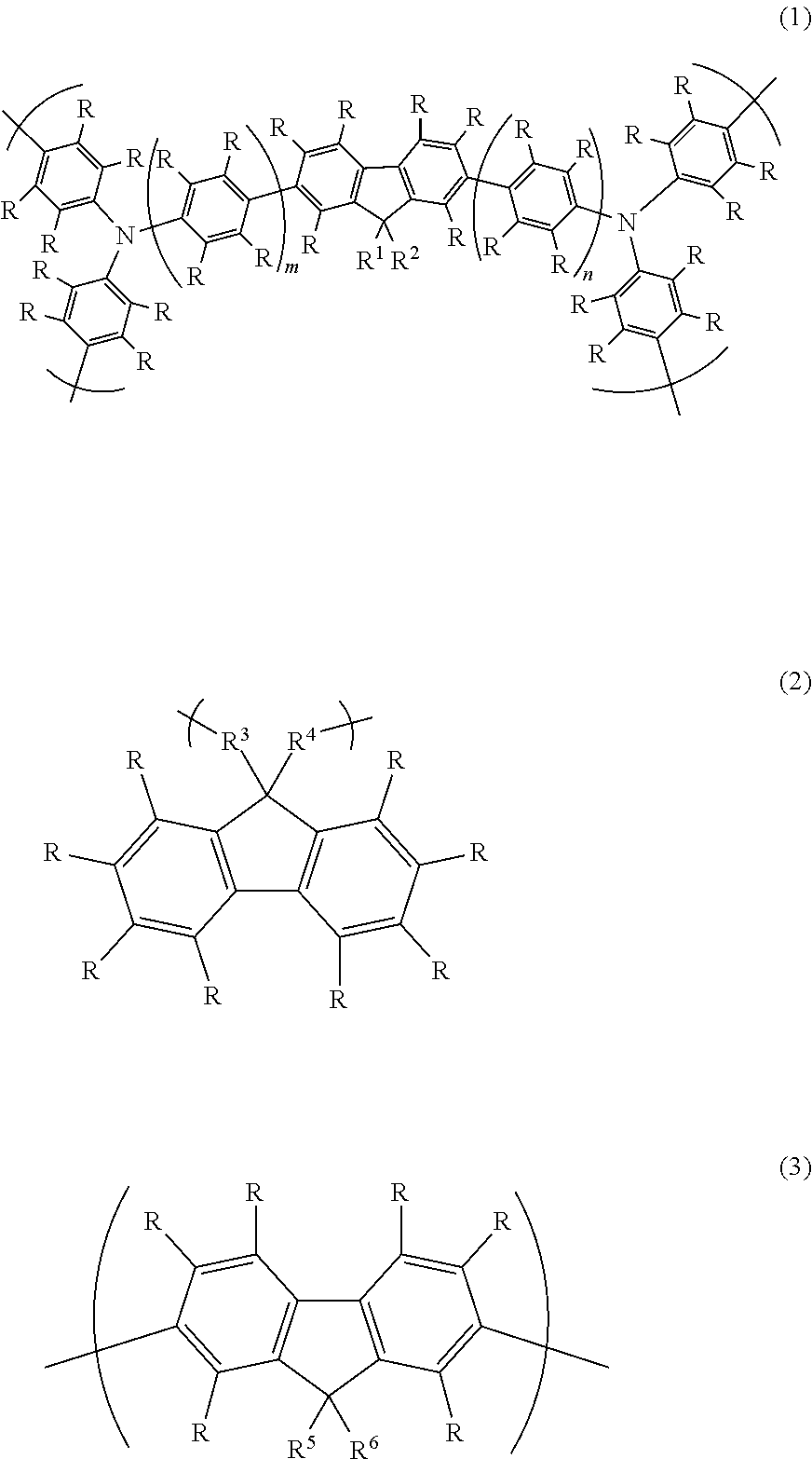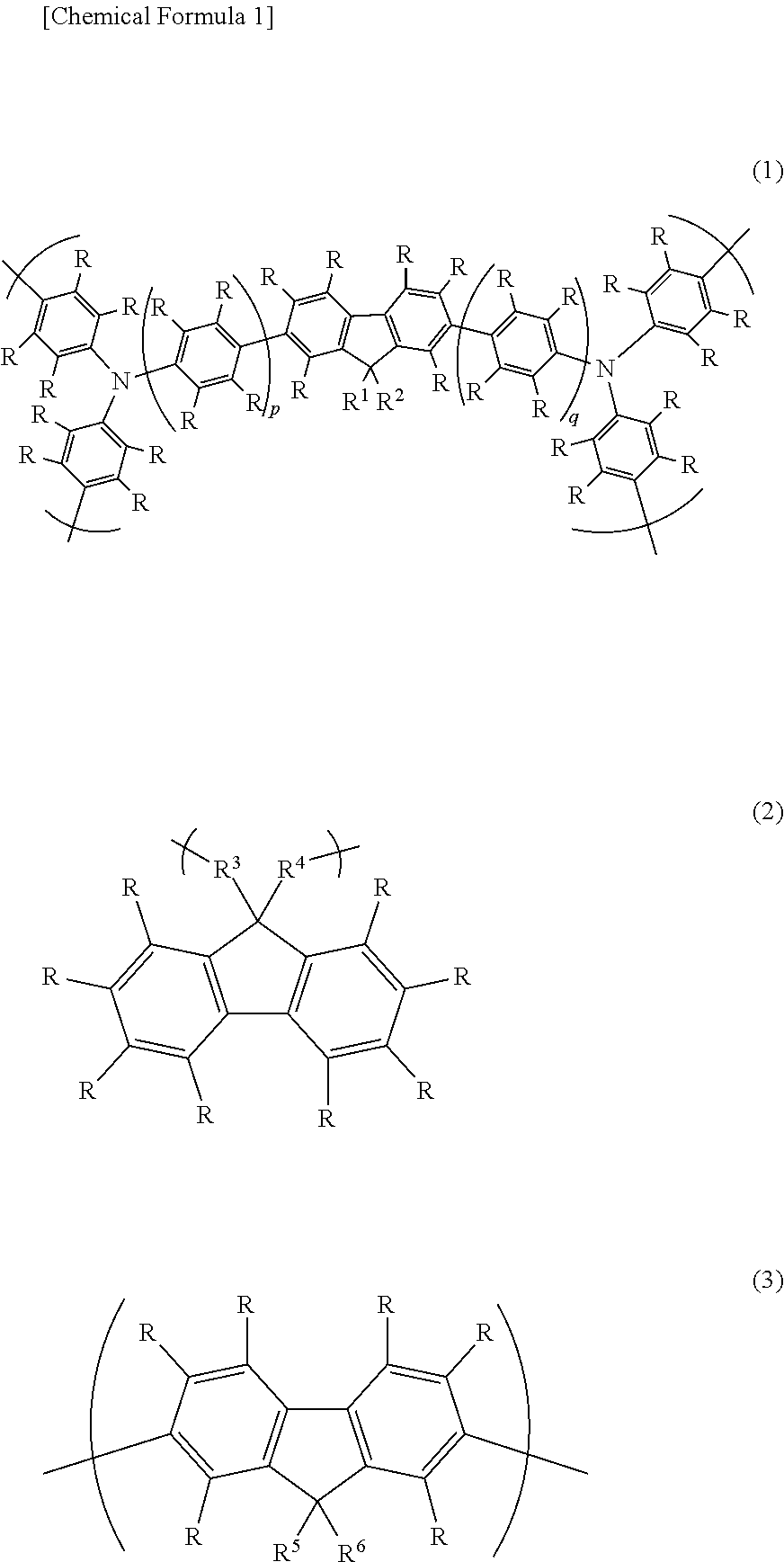Fluorine atom-containing polymer and use of same
a technology of fluorine atoms and polymers, which is applied in the direction of organic chemistry, group 3/13 element organic compounds, luminescent compositions, etc., can solve the problems of requiring independent steps to form the respective layers, and the production process of organic el devices also has the drawbacks, so as to achieve excellent brightness characteristics
- Summary
- Abstract
- Description
- Claims
- Application Information
AI Technical Summary
Benefits of technology
Problems solved by technology
Method used
Image
Examples
synthesis example 1
[Synthesis Example 1] Synthesis of Compound 1
[0326]
[0327]Potassium hydroxide (5.61 g, 100 mmol), potassium iodide (0.33 g, 2 mmol) and diethylene glycol 2-bromoethyl methyl ether (9.99 g, 44 mmol) were added to a dimethylsulfoxide suspension (130 mL) of 2,7-dibromofluorene (6.48 g, 20 mmol), and the system was stirred at room temperature for 24 hours. Following reaction completion, the system was cooled to 0° C., water (120 mL) was added, and neutralization was carried out with hydrochloric acid. The crude product obtained by extracting the organic layer with ethyl acetate, drying over magnesium sulfate and concentration was purified by silica gel column chromatography (eluate, hexane / ethyl acetate (4 / 1→3 / 1→2 / 1)), giving 8.30 g (yield, 67%) of Compound 1 as a white solid. The 1H-NMR and LC / MS results were as follows.
[0328]1H-NMR (300 MHz, CDCl3):
[0329]δ 2.33 (app t, J=7.8 Hz, 4H), 2.78 (app t, J=7.8 Hz, 4H), 3.19-3.22 (m, 4H), 3.35 (s, 6H), 3.37-3.41 (m, 4H), 3.50-3.52 (m, 8H), 7.46...
synthesis example 2
[Synthesis Example 2] Synthesis of Compound 2
[0331]
[0332]Palladium acetate (40.4 mg, 0.18 mmol), t-BuONa (3.81 g, 40 mmol) and [(t-Bu)3PH]BF4 (104 mg, 0.36 mmol) were added to a toluene solution (56 mL) of diphenylamine (4.61 g, 27 mmol) and Compound 1 (5.60 g, 9 mmol), and the system was flushed with nitrogen, then heated at 80° C. for 3 hours. Following reaction completion, the crude product obtained by Celite filtration and concentration of the filtrate was purified by silica gel column chromatography (eluate:hexane / ethyl acetate (2 / 1→1 / 1→1 / 2)), giving 1.17 g (16% yield) of Compound 2 as a light-brown solid. The 1H-NMR and LC / MS results were as follows.
[0333]1H-NMR (300 MHz, CDCl3):
[0334]δ 2.13 (app t, J=7.2 Hz, 4H), 2.88 (app t, J=7.2 Hz, 4H), 3.28-3.31 (m, 4H), 3.34 (s, 6H), 3.45-351 (m, 8H), 3.54-3.58 (m, 4H), 6.98-7.11 (m, 16H), 7.22-7.27 (m, 8H), 7.44 (d, J=8.1 Hz, 2H).
[0335]LC / MS (ESI+) m / z; 794 [M+H]+
synthesis example 3
[Synthesis Example 3] Synthesis of Compound 3
[0336]
[0337]N-bromosuccinimide (2.73 g, 15.4 mmol) was added at 0° C. to a DMF solution (58 mL) of Compound 2 (2.90 g, 3.7 mmol), following which the system was stirred at room temperature for 1 hour. Following reaction completion, water (58 mL) was added at 0° C. and the organic layer was extracted with ethyl acetate. The crude product obtained by drying the extract over sodium sulfate and concentration was purified by silica gel column chromatography (eluate:hexane / ethyl acetate (413 / 1)), giving 3.95 g (93% yield) of Compound 3 as a white solid. The 1H-NMR and LC / MS results were as follows.
[0338]1H-NMR (300 MHz, CDCl3):
[0339]δ 2.14 (app t, J=7.2 Hz, 4H), 2.86 (app t, J=7.2 Hz, 4H), 3.26-333 (m, 4H), 3.35 (s, 6H), 3.41-3.57 (m, 12H), 6.83-7.05 (m, 12H), 7.25-7.47 (m, 10H).
[0340]LC / MS (ESI+) m / z; 1131 [M+Na]+
PUM
| Property | Measurement | Unit |
|---|---|---|
| Current density | aaaaa | aaaaa |
| Current density | aaaaa | aaaaa |
| Current density | aaaaa | aaaaa |
Abstract
Description
Claims
Application Information
 Login to View More
Login to View More - R&D
- Intellectual Property
- Life Sciences
- Materials
- Tech Scout
- Unparalleled Data Quality
- Higher Quality Content
- 60% Fewer Hallucinations
Browse by: Latest US Patents, China's latest patents, Technical Efficacy Thesaurus, Application Domain, Technology Topic, Popular Technical Reports.
© 2025 PatSnap. All rights reserved.Legal|Privacy policy|Modern Slavery Act Transparency Statement|Sitemap|About US| Contact US: help@patsnap.com



